|

from
TheIntentionExperiment Website
Background
Measuring Light From Water
Russian physicist Dr.
Konstantin Korotkov of St.
Petersburg State Technical University invented the Gas Discharge
Visualization (GDV)
technique, which makes use of state-of-the-art optics, digitized
television matrices and a powerful computer.
Ordinarily, a living thing will dribble
out the faintest pulse of photons, perceptible only to the most
sensitive equipment in conditions of utter pitch black.
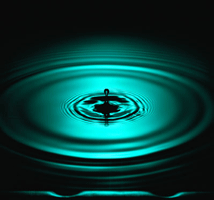
Korotkov captures the tiny pulse of
photons emitted by all living things by stirring them up -
‘evoking’, or stimulating them into an excited state so that they
shine millions of times more intensely than normal.
Korotkov’s equipment blends several techniques: photography,
measurements of light intensity and computerized pattern
recognition. When used on humans, his camera takes pictures of the
field around each of the 10 fingers, one finger at a time.
A computer program then extrapolates from this a real-time image of
the ‘biofield’ surrounding the person and deduces from it the state
of health in the case of a person.
Like People,
Liquids - Water Included - Glow
In the case of liquids, the GDV machine examines the emission
activity on the surface of the liquid - that is, its ability to
retain important information from other molecules.
The emission activity of the surface of these liquids depends upon
the presence of clusters of hydrogen atoms with a special ability to
bond. It is this special property, Korotkov believes, that gives
water its unique capacity to record and retain information.
Tests on
Liquids
Korotkov and his team have carried out a great deal of pilot
research on a great variety of biological liquids, showing that the
GDV equipment is highly sensitive to changes in the chemical and
physical contents of liquids - subtle changes that don’t show up in
ordinary chemical analyses.
For instance, Korotkov discovered statistically significant
differences between the blood samples of healthy people and those
patients suffering from cancer or heart disease. He has also found
statistically significant changes in water after it was irradiated -
even when when homeopathic remedies diluted 30 times were added to
it (Consciousness and Physical Reality (in Russian) 1998; 3 (1):
51-8; J of Alternative and Complementary Medicine, 2003; 9 (1):
25-37; J of Applied Physics, 2004; 95 ( 7): 3334-8).
His equipment is so sensitive that it can detect tiny differences in
between the glow of natural and synthetic essential oils with the
identical chemical composition - differences that don’t show up
through other means of chemical analysis.
GDV equipment has been able to accurately detect differences between
oils that are organic, compared with those produced by ordinary
means; between oils obtained in different climatic conditions or
extracted by means of different methods; and between those that are
fresh compared with those that have been oxidized.
Healing
Changes Water
Since 2001 Dr. Korotkov has investigated the remote mental influence
of a healer on water samples from different distances and in
different modes. Numerous experiments or his have demonstrated that
mental influence results in statistically significant changes of the
electrophotonic quality (the ‘glow’) of water.
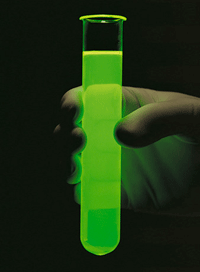
In one of his studies, he enlisted German healer Christos
Drossinakis, who sent his mental influence from Japan and
Germany at 12 a.m. for 10 minutes to a bottle. Researchers
performing the measurements were unaware of when he was sending
intention and which target bottle it was.
Significant changes in electrophotonic parameters of water drops
between samples from different bottles were found on days when
Drossinaki was sending healing from Japan. During control periods,
no significant reproducible difference between samples were found.
In another experiment, a sample of drinking water was divided into
three vials. A drop of eucalyptus oil was added to one, while the
two others were sent intention by Russian healers. When Korotkov
analyzed the results, he found that human influence was stronger
than the impact of oil added to water.
Although these studies are simply observations, at this point, they
offer evidence of water as a means of information storage, which
varies under the influence of human intention.
As Korotkov writes: It may be that this ‘structurized’ water
influences the person who drinks it.
If we manage to prove these hypotheses
experimentally, new insights in understanding of the world and
health will open up.
“We could even prove that the
quality of food depends on the mental mood of the person who
prepared it.”
How our Water
Experiment was Run
On November 30, Dr. Korotkov filled a test tube to the top with
distilled water from a pharmacy in St. Petersburg, Russia. He then
inserted an electrode into the test tube, so that water began to run
down its sides, to ensure there was no air in the test tube.
The electrode was then secured with
tape, as shown below.
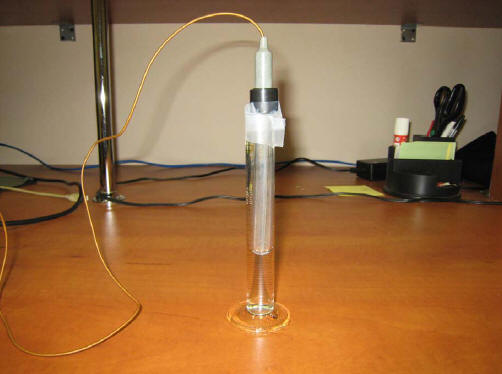
This electrode was then connected to a
cylinder and standard GDV equipment.
Glowing from
Intention
Ordinarily, when a bottle of ordinary water is first opened, its
‘glow’ is highly variable before it settles down after two minutes.
Korotkov chose distilled water for our experiment because its glow
doesn’t have this kind of initial variation but should remain
relatively stable over time.
At this time, The Intention Experiment enlisted participants
from all over the world and asked them to send love to this sample
of water.
We had wanted to create a simple scientific experiment to prove the
claims of
Masaru Emoto - that love sent
to water changes its structure - in a rigorous scientific setting
under scientific conditions.
The Intention Experiment website
published a photo of the vial of water, which was visible only
to those who had agreed to register for the experiment. Nearly
3000 people had signed up to participate from eighty countries
around the globe.
Although two-thirds were from the US,
Canada, the UK and the Netherlands and other English speaking
countries like New Zealand and Australia, we also had a large
showing from every country in Europe and then many far-flung places:
We had representatives from every
continent other than Antarctica. On the day, some 1500 actually
participated. Sixty two per cent - nearly two-thirds - were regular
meditators, and nearly half had read
The Intention Experiment.
Nearly 80 per cent were participating
for the first time.
Experimental Process
At 7: 38 pm St. Petersburg time (4:38 GMT) Korotkov turned on his
GDV instruments, and kept them on for roughly an hour. Only a single
experimenter was in the room. During the experiment, Rachmaninov
played on a CD.
Dr. Korotkov says that the purpose of
our experiment was to measure the signals being emitted from the
water and to compare the signals before intention with those during
the intention and then afterward.
To register the subtlest of changes, he examined many parameters,
including the power of the signal (its area) and the spectrum of the
signal (its intensity).
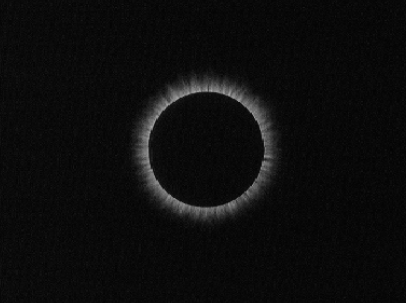
When he examined the effects 10 minutes
before and compared it with the effect during intention, he
discovered a highly significant change.
Korotkov chose three intervals to study and compare emissions:
He then compared the size and intensity
of emissions and their state of ‘order’ by looking at such
measurements as the total area and average intensity of light
emissions.
Large Changes
in Light
He discovered large differences in a number of parameters, including
the intensity of light. Here’s a chart showing the effect of
intention and also the variation in the emissions of the water.
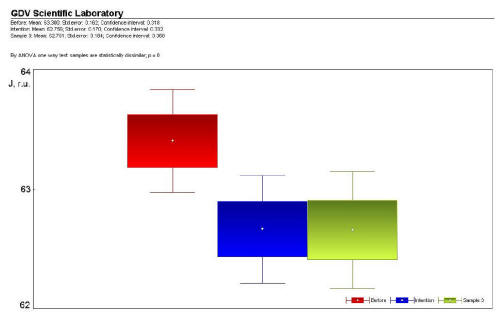
In the graph below, which shows a time
line of the experiment, after the instrument was turned on we had a
strong variations in the light emissions - contrary to Korotkov’s
expectations.
These variations came to a halt six
minutes before the planned intention time and only started again
once we were finished.
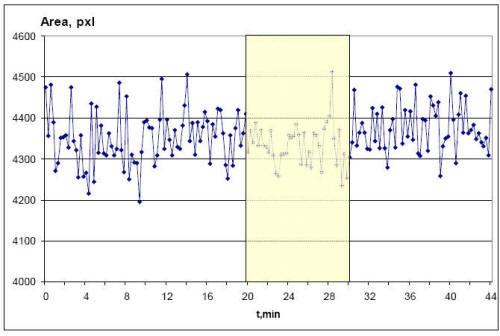
These figures show a significant effect
in changing the area emissions of the water.
Nevertheless, if you look at the comparison between the time of
intention and 20 minutes before, the significance in his data
disappears. In the Second Water Experiment, we refined the
experiment and studied the data over a longer time frame.
Charged
Water
Korotkov hypothesizes three things about water whose structure has
been ‘charged’ with love. First, the ‘structurized water’ affects
the space where the water sample is - as William Tiller discovered,
in his Black Box experiments (see
The Intention Experiment,
chapter 8). It makes it like a sacred space.
Korotkov also theorizes that this structurized water could change
the state of the person who drinks it.
If know we can change and ‘improve’ water by sending love to it, we
could have a healing effect on everything that contains water: food,
drinking water - indeed every living thing. Remember that all
animals (us included) are approximately 80 per cent water and all
plants almost 100 per cent water.
Nevertheless, this is only a demonstration of a possible effect. We
need to repeat the experiment several times to show without a doubt
that our intention changed this structure bonding ability.
Experience
Counts
The design of water experiment was itself an experiment.
In the past, we have made these
experiments open only to those people who have read The Intention
Experiment, digested its contents and practiced Powering Up,
Lynne McTaggart’s program for maximizing intention.
Because these are rigorous scientific experiments, we had wanted to
increase the likelihood of success by using only a coherent,
homogeneous group of participants, who were experienced in sending
intention using identical techniques.
This was our first experiment open to the public, where participants
could be unpracticed in Powering Up. As it happened, we have
a fairly practiced group - two-thirds, were experienced meditators,
and we sent all participants abbreviated instructions for
Powering Up.
Nevertheless, in a group not long practiced, individual ideas of
focusing mind and the like might differ greatly.
Robust as our effect was, it was not as strong as that of an
experienced healer. This graph shows happened when a Russian healer
named V. Sochevano sent healing to a vial of water.
The influence time is between A and B.
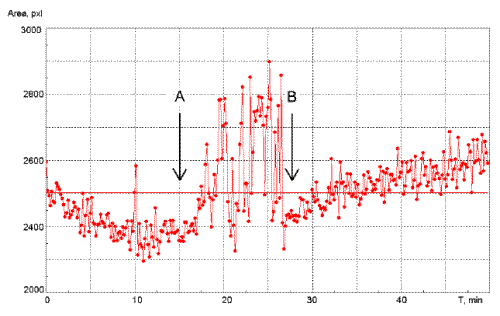
As Dr. Korotkov says,
‘This healer was very, very
experienced. He knew how to generate specific frequencies, which
is why his effect was huge.’
Our effect was indeed smaller.
As with our Germination Experiments,
it seems that experience in intention counts: the more experienced
the intender, the greater his effects. From this experiment, we also
concluded that it was important to make our intention to water more
specific. All we had specified was to send love.
The problem is that the idea of love is highly individual.
‘Indeed,’ says Dr. Korotkov, ‘some
of the intentions could have interfered with others.’
In other experiments, The Intention
Experiment has produced the largest effect with a highly
specific intention. The fact that participants are placed all over
the globe again did not seem to matter.
What may matter, however, is becoming a
coherent, focused group who occupies the same ‘psychic’ space.
|







